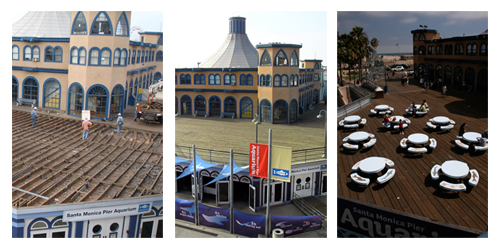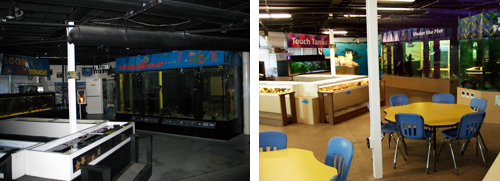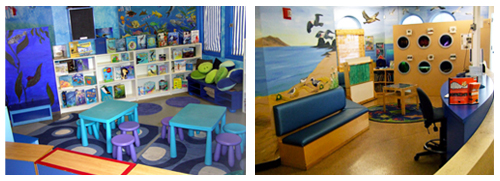Today’s blogger is Vicki Wawerchak, director at Heal the Bay’s Santa Monica Pier Aquarium.
March 1, 2012 marks the nine-year anniversary of Heal the Bay’s management of the current Santa Monica Pier Aquarium. As staff celebrates the many changes, successes and victories over the past nine years, we thought it would be great to share some of those with you in this four-part series.
We acquired the Aquarium (previously known as the Ocean Discovery Center) in 2003 from UCLA. Since that time we have welcomed more than 123,000 students through our field trip education programs and more than 527,000 visitors have passed through our doors during public hours.
One of the first facility projects we completed was the installation of a new roof for the building in 2006. Although this enhancement was not apparent to the average visitor, it was a vital necessity for safety of the staff, volunteers, animals and for the successful operation of the equipment housed within the Aquarium. The leaky roof compromised not only the office equipment, flooring and exhibit structures, but also the sanity of staff — since we were hauling sandbags around to plug the leaks every time it rained.
To re-roof, the pier decks were removed, a new membrane was fitted, stringers were replaced and new lumber was installed above the Aquarium. As timing would have it, we experienced a drought the year following the installation of the new roof. Since then however, we have had some significant rainstorms and the new addition has kept us all dry and eased our fears of getting fresh water into our salt water system.

The roof during construction and after
When the roof was replaced, the new pier deck platform became a perfect, clean slate for us to discuss how we could use that area to promote the Aquarium. We discussed a number of options before finally deciding on fabricating and installing a three- dimensional, functional, marine-themed project that would raise awareness about the Aquarium. We hired A & E Sculpting and Paint Studio to create custom tables and chairs focusing on local species. The tables and chairs, which were installed in 2010, allow our field trip education groups a place for lunch and offers other pier goers an opportunity to stop and enjoy the East end of the Pier.
Now, when we are working downstairs in our offices, we can hear the pitter-patter of tiny, excited feet running overhead and know that many school groups are benefiting from that project.
Read part two of the four-part series.








